Small-Sided Games in Youth Football: Advancing Technical–Tactical Performance and Social Inclusion for Sustainable Development
Abstract
1. Introduction
Social Inclusion Through Sport
2. Study Purpose
3. Materials and Methods
Eligibility, Observation Window, and Sample Size
- Introductory Phase (≈30 min)—dynamic stretching and activation games such as handball-style possession (aiming at spatial awareness and mobility under constraints) and 4v4+4 rondo formats (promoting rapid ball circulation, pressure resistance, and support play).
- Fundamental Phase (≈65 min)—progressive SSG scenarios targeting offensive and transitional dynamics:
- 3.
- Closing Phase (≈5 min)—low-intensity jogging, stretching, breathing exercises, and coach–player feedback to consolidate physical recovery and reflective learning.
4. Results
4.1. Teting Social Inclusion Rate
4.2. SSGs Training Fidelity Analysis
4.3. Testing Technical/Tactical Offensive Actions
4.4. Testing Technical/Tactical Defensive Actions
4.5. Testing the Number of Scored Goals
- -
- the number of crosses increased from 4.63 to 6.88 (+2.25);
- -
- the number of crosses with ball possession increased from 2.81 to 3.69 (+0.875);
- -
- the number of corner kicks increased from 2.5 to 3.69 (+1.1875);
- -
- the number of penalty kicks increased from 1.19 to 1.31 (+0.125);
- -
- the number of throw-ins from the own half decreased from 3.94 to 2.69 (−1.25);
- -
- the number of throw-ins from the opponent’s half increased from 2.5 to 4.38 (+1.875).
- -
- vertical releases—from 5.75 to 4.31 (−1.4375);
- -
- diagonal releases—from 4.19 to 3.88 (−0.3125).
5. Discussion
5.1. Technical–Tactical Development Through SSGs
5.2. Social Inclusion and Team Participation
5.3. Alignment with the Sustainable Development Goals (SDGs)
5.4. Methodological Considerations
5.5. Future Directions
5.6. Summary
6. Conclusions
Author Contributions
Funding
Institutional Review Board Statement
Informed Consent Statement
Data Availability Statement
Conflicts of Interest
Appendix A. Perceived Inclusion Scale
| Year | Stat | Belonging | Voice | Correctness | Respect | Clarity | Opportunity | Pleasure | Year |
|---|---|---|---|---|---|---|---|---|---|
| 2023 | Mean | 1.83 | 1.39 | 1.48 | 1.65 | 1.48 | 1.48 | 1.70 | 2023 |
| 2023 | SD | 0.72 | 0.58 | 0.51 | 0.57 | 0.51 | 0.59 | 0.47 | 2023 |
| 2023 | CI | 0.31 | 0.25 | 0.22 | 0.25 | 0.22 | 0.26 | 0.20 | 2023 |
| 2024 | Mean | 2.78 | 2.57 | 2.70 | 2.78 | 2.43 | 2.83 | 2.96 | 2024 |
| 2024 | SD | 0.52 | 0.79 | 0.63 | 0.52 | 0.51 | 0.83 | 0.71 | 2024 |
| 2024 | CI | 0.22 | 0.34 | 0.27 | 0.22 | 0.22 | 0.36 | 0.31 | 2024 |
| 2025 | Mean | 3.65 | 3.87 | 3.96 | 4.00 | 3.87 | 4.04 | 4.39 | 2025 |
| 2025 | SD | 0.71 | 0.69 | 0.71 | 0.67 | 0.63 | 0.71 | 0.50 | 2025 |
| 2025 | CI | 0.31 | 0.30 | 0.31 | 0.29 | 0.27 | 0.31 | 0.22 | 2025 |
Appendix B. Small-Sided Games (SSG) Fidelity Checklist
Appendix C. Training Plan 10
| Training Part | Means | Work Training | Dose | Observations | |
|---|---|---|---|---|---|
| 1 | Part Introduction 30 min | 1. Handball (15 min) Players run and stretch in the first 5 min. Players then progress to a possession game using only their hands. Ten passes equals one goal. Players are not allowed to move with the ball in their hand. Players must move away from the ball to create passing options. Players are only allowed to hold the ball for three seconds. After that, I can only run 3 steps and the speed increases. At the end 5 min stretching | 4 columns | 15 min | 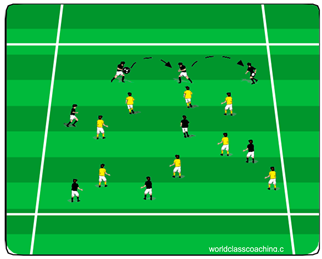 |
| 2. 4 vs. 4+4 Each team has four players. Black’s players are on the outside, they each have a ball. They try to pass the ball to the players of the Yellow team who pass it back with a single touch. The Red Team must score the Yellow Team. Every 5 min the roles change. | 3 teams | 15 min |  | ||
| 2 | The fundamental part 65 min | 1. 2 teams. The goalkeeper throws the ball into the opponent’s half where an attempt is made to win the ball, followed by completion in time as quickly as possible. | 2 teams | 20 min | 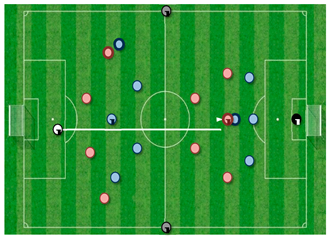 |
| 2. Shipping: 4 vs. 4 in a square with 2/4 jokers. The team that makes 10 passes can complete and the team that recovers the ball goes to finish with the 2/4 jokers. | 4 teams | 20 min | 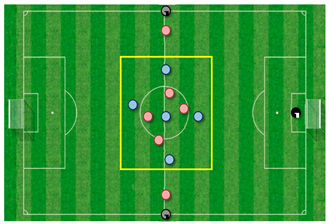 | ||
| 3. Bilateral play | 2 teams | 20 min | 1/2 plot | ||
| 3 | Part Conclusion 5 min | -Easy running -Walking with breath -Stretching -Feedback | Individual -The whole team |
- -
- Be careful when exiting crowded areas with ball passing, one-two, dribbling or changing the direction of play.
- -
- The stretching exercises at the end of the workout are relaxation stretching, especially on muscle groups requested.
References
- Javier, D.G.; Martín, J.; Jesús, P. Fútbol y Racismo: Un Problema Científico y Social. Soccer and Racism: A Scientific and Social Problem. RICYDE Rev. Int. Cienc. Deporte 2006, 3, 68–94. Available online: http://www.cafyd.com/REVISTA/art5n3a06.pdf (accessed on 12 May 2025).
- Blondeau, J. The Influence of Field Size, Goal Size and Number of Players on the Average Number of Goals Scored per Game in Variants of Football and Hockey: The Pi-Theorem Applied to Team Sports. J. Quant. Anal. Sports 2020, 17, 145–154. [Google Scholar] [CrossRef]
- Davies, M.J.; Young, W.; Farrow, D.; Bahnert, A. Comparison of Agility Demands of Small-Sided Games in Elite Australian Football. Int. J. Sports Physiol. Perform. 2013, 8, 139–147. [Google Scholar] [CrossRef]
- World Bank. Inclusion Matters: The Foundation for Shared Prosperity. The Report Defines Social Inclusion as “The Process of Improving the Ability, Opportunity, and Dignity of People, Disadvantaged on the Basis of Their Identity, to Take Part in Society”. 2013. Available online: https://documents1.worldbank.org/curated/en/099819401222443265/pdf/IDU175f35c9f149be1458318ec61979fcfa7dd5e.pdf (accessed on 12 May 2025).
- Pečnikar Oblak, V.; Campos, M.J.; Lemos, S.; Rocha, M.; Ljubotina, P.; Poteko, K.; Kárpáti, O.; Farkas, J.; Perényi, S.; Kustura, U.; et al. Narrowing the Definition of Social Inclusion in Sport for People with Disabilities through a Scoping Review. Healthcare 2023, 11, 2292. [Google Scholar] [CrossRef]
- Vilamitjana, J.J. Soccer, an Opportunity for Social Integration. Boletín Electrónico REDAF 2014, 73, 2–7. [Google Scholar] [CrossRef]
- Ferreira, M.M. Soccer and its Educational and Social Possibilities. Cult. Cienc. Y Deporte 2006, 4, 13–19. Available online: https://www.homelessworldcup.org/ (accessed on 12 May 2025).
- Sánchez-Sánchez, J.; Yagüe, J.M.; Fernández, R.C.; Petisco, C. Effects of small-sided games training on technique and physical condition of young footballers. RICYDE Rev. Int. Cienc. Deporte 2014, 41, 245–257. [Google Scholar] [CrossRef]
- Rampinini, E.; Impellizzeri, F.M.; Castagna, C.; Abt, G.; Chamari, K.; Sassi, A.; Marcora, S.M. Factors influencing physiological responses to small-sided soccer games. J. Sports Sci. 2007, 25, 659–666. [Google Scholar] [CrossRef] [PubMed]
- Little, T. Optimizing the Use of Soccer Drills for Physiological Development. Strength Cond. J. 2009, 31, 67–74. [Google Scholar] [CrossRef]
- Owen, A.L.; Ford, P.R.; Twist, C. Small-Sided Games: The Physiological and Technical Effect of Altering Pitch Size and Player Numbers. Insight 2004, 7, 50–53. [Google Scholar]
- Barnabé, L.; Volossovitch, A.; Ferreira, A.P. Effect of Small-Sided Games on the Physical Performance of Young Football Players of Different Ages and Levels of Practice. In Performance Analysis of Sport IX; Peters, D., O’Donoghue, P., Eds.; Routledge: Abingdon, UK, 2014; pp. 71–76. [Google Scholar]
- Almeida, C.H.; Volossovitch, A.; Duarte, R. Influence of Scoring Mode and Age Group on Passing Actions during Small-Sided and Conditioned Soccer Games. Hum. Mov. 2017, 18, 125–134. [Google Scholar] [CrossRef]
- Bonney, N.; Ball, K.; Berry, J.; Larkin, P. Effects of Manipulating Player Numbers on Technical and Physical Performances Participating in an Australian Football Small-Sided Game. J. Sports Sci. 2020, 38, 2430–2436. [Google Scholar] [CrossRef] [PubMed]
- Santos, F.J.; Figueiredo, T.; Ferreira, C.; Espada, M. Physiological and Physical Effects Associated with Task Constraints, Pitch Size, and Floater Player Participation in U-12 1 × 1 Soccer Small-Sided Games. Hum. Mov. 2022, 23, 54–62. [Google Scholar] [CrossRef]
- Borges, P.H.; da Costa, J.C.; Ramos-Silva, L.F.; Praça, G.M.; Vaz Ronque, E.R. Combined Effect of Game Position and Body Size on Network-Based Centrality Measures Performed by Young Soccer Players in Small-Sided Games. Front. Psychol. 2022, 13, 873518. [Google Scholar] [CrossRef]
- Sangnier, S.; Cotte, T.; Brachet, O.; Coquart, J.; Tourny, C. Planning Training Workload in Football Using Small-Sided Games’ Density. J. Strength Cond. Res. 2019, 33, 2801–2811. [Google Scholar] [CrossRef]
- Modena, R.; Togni, A.; Fanchini, M.; Pellegrini, B.; Schena, F. Influence of Pitch Size and Goalkeepers on External and Internal Load during Small-Sided Games in Amateur Soccer Players. Sport Sci. Health 2021, 17, 797–805. [Google Scholar] [CrossRef]
- Sannicandro, I. Small-Sided Games and Size Pitch in Elite Female Soccer Players: A Short Narrative Review. J. Hum. Sport Exerc. 2021, 16, S361–S369. [Google Scholar] [CrossRef]
- Clemente, F.M.; Wong, D.P.; Martins, F.M.L.; Mendes, R.S. Acute Effects of the Number of Players and Scoring Method on Physiological, Physical, and Technical Performance in Small-Sided Soccer Games. Res. Sports Med. 2014, 22, 380–397. [Google Scholar] [CrossRef] [PubMed]
- Ministry of Football. Using Small-Sided Games. 2024. Available online: https://ministry-of-football.com/small-sided-games/ (accessed on 12 May 2025).
- Casamichana Gómez, D.; Castellano Paulis, J.; González-Morán, A.; García-Cueto, H.; García-López, J. Physiological Demand in Small-Sided Games on Soccer with Different Orientation of Space. RICYDE Rev. Int. Cienc. Deporte 2011, 23, 141–154. Available online: http://www.cafyd.com/REVISTA/02306.pdf (accessed on 12 May 2025). [CrossRef]
- Castellano, J.; Fernández, E.; Echeazarra, I.; Barreira, D.; Garganta, J. Influence of Pitch Length on Inter-and Intra-Team Behaviors in Youth Soccer. An. Psicol. 2017, 33, 486–496. [Google Scholar] [CrossRef]
- Clemente, F.M.; Ramirez-Campillo, R.; Sarmento, H.; Praça, G.M.; Afonso, J.; Silva, A.F.; Rosemann, T.J.; Knechtle, B. Effects of Small-Sided Game Interventions on the Technical Execution and Tactical Behaviors of Young and Youth Team Sports Players: A Systematic Review and Meta-Analysis. Front. Psychol. 2021, 12, 667041. [Google Scholar] [CrossRef]
- Barnabé, L.; Volossovitch, A.; Duarte, R.; Ferreira, A.P.; Davids, K. Age-Related Effects of Practice Experience on Collective Behaviours of Football Players in Small-Sided Games. Hum. Mov. Sci. 2016, 48, 74–81. [Google Scholar] [CrossRef]
- Frencken, W.; Lemmink, K.; Delleman, N.; Visscher, C. Oscillations of Centroid Position and Surface Area of Soccer Teams in Small-Sided Games. Eur. J. Sport Sci. 2011, 11, 215–223. [Google Scholar] [CrossRef]
- Hill-Haas, S.V.; Dawson, B.T.; Impellizzeri, F.M.; Coutts, A.J. Physiology of Small-Sided Games Training in Football: A Systematic Review. Sports Med. 2011, 41, 199–220. [Google Scholar] [CrossRef] [PubMed]
- Sampaio, J.E.; Lago, C.; Gonçalves, B.; Maças, V.M.; Leite, N. Effects of Pacing, Status and Unbalance in Time Motion Variables, Heart Rate and Tactical Behaviour when Playing 5-A-Side Football Small-Sided Games. J. Sci. Med. Sport 2013, 17, 229–233. [Google Scholar] [CrossRef]
- Hill-Haas, S.V.; Coutts, A.J.; Rowsell, G.J.; Dawson, B.T. Generic versus Small-Sided Game Training in Soccer. Int. J. Sports Med. 2009, 30, 636–642. [Google Scholar] [CrossRef]
- Kelly, D.M.; Drust, B. The Effect of Pitch Dimensions on Heart Rate Responses and Technical Demands of Small-Sided Soccer Games in Elite Players. J. Sci. Med. Sport 2009, 12, 475–479. [Google Scholar] [CrossRef]
- Aroso, J.; Rebelo, A.; Gomes-Pereira, J. Physiological Impact of Selected Game-Related Exercises. J. Sports Sci. 2004, 22, 522. [Google Scholar]
- Jones, S.; Drust, B. Physiological and Technical Demands of 4v4 and 8v8 Games in Elite Youth Soccer Players. Kinesiology 2007, 39, 150–156. [Google Scholar]
- Katis, A.; Kellis, E. Effects of Small-Sided Games on Physical Conditioning and Performance in Young Soccer Players. J. Sports Sci. Med. 2009, 8, 374–380. [Google Scholar] [PubMed]
- Little, T.; Williams, A.G. Suitability of Soccer Training Drills for Endurance Training. J. Strength Cond. Res. 2006, 20, 316–319. [Google Scholar]
- Williams, K.; Owen, A.L. The Impact of Player Numbers on the Physiological Responses to Small-Sided Games. J. Sports Sci. Med. 2007, 6, 99–102. [Google Scholar]
- Hoff, J.; Wisloff, U.; Engen, L.C.; Kemi, O.J.; Helgerud, J. Soccer Specific Aerobic Endurance Training. Br. J. Sports Med. 2002, 36, 218–221. [Google Scholar] [CrossRef] [PubMed]
- Mallo, J.; Navarro, E. Physical Load Imposed on Soccer Players during Small-Sided Training Games. J. Sports Med. Phys. Fit. 2008, 48, 166–171. [Google Scholar]
- Hill-Haas, S.V.; Coutts, A.J.; Dawson, B.T.; Rowsell, G.J. Time-Motion Characteristics and Physiological Responses of Small-Sided Games in Elite Youth Players: The Influence of Player Number and Rule Changes. J. Strength Cond. Res. 2010, 24, 2149–2156. [Google Scholar] [CrossRef]
- Tessitore, A.; Meeusen, R.; Piacentini, M.F.; Demarie, S.; Capranica, L. Physiological and Technical Aspects of “6-A-Side” Soccer Drills. J. Sports Med. Phys. Fit. 2006, 46, 36–43. [Google Scholar]
- Hair, J.F.; Risher, J.J.; Sarstedt, M.; Ringle, C.M. When to Use and How to Report the Results of PLS-SEM. Eur. Bus. Rev. 2019, 31, 2–24. [Google Scholar] [CrossRef]
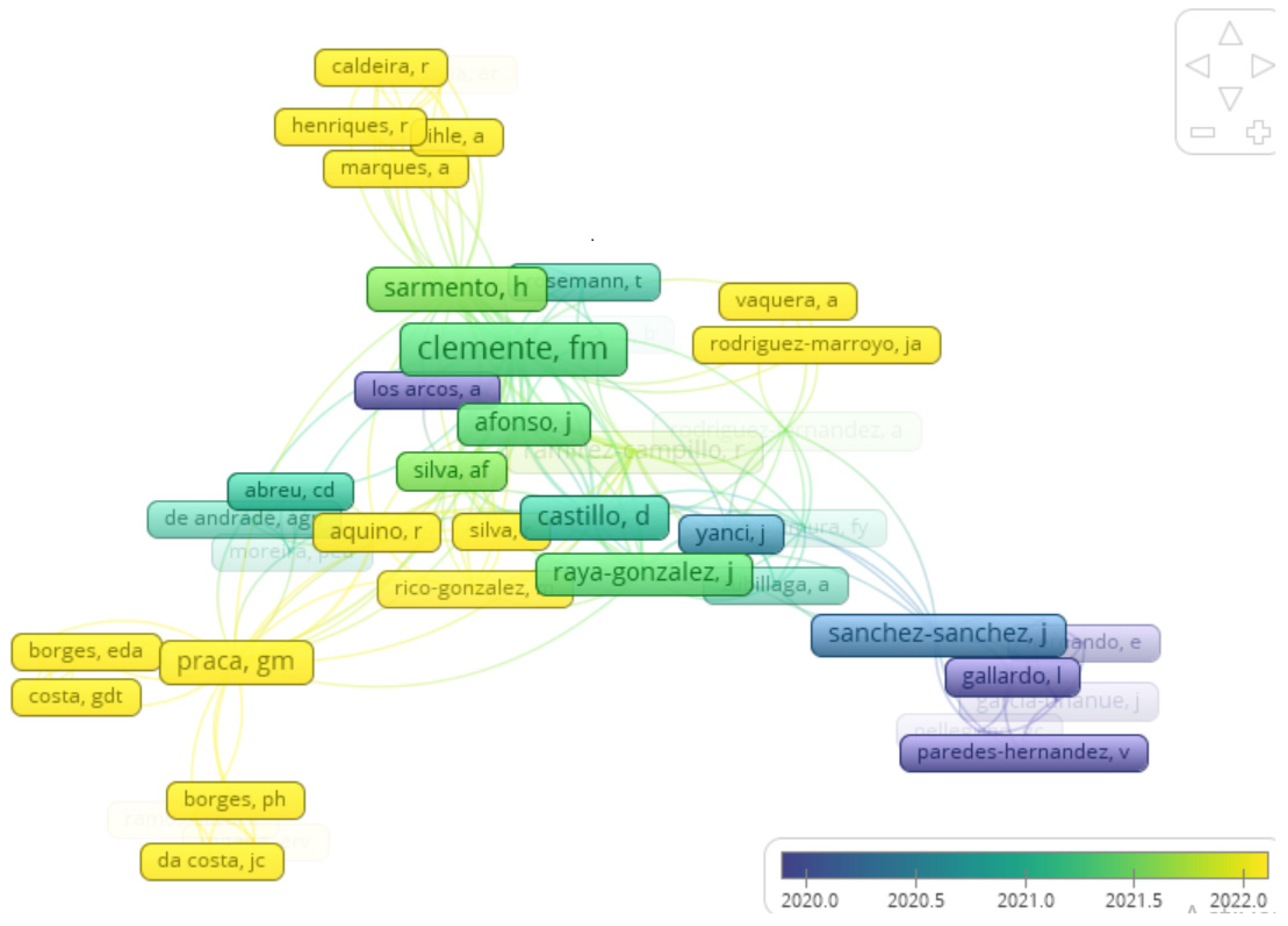
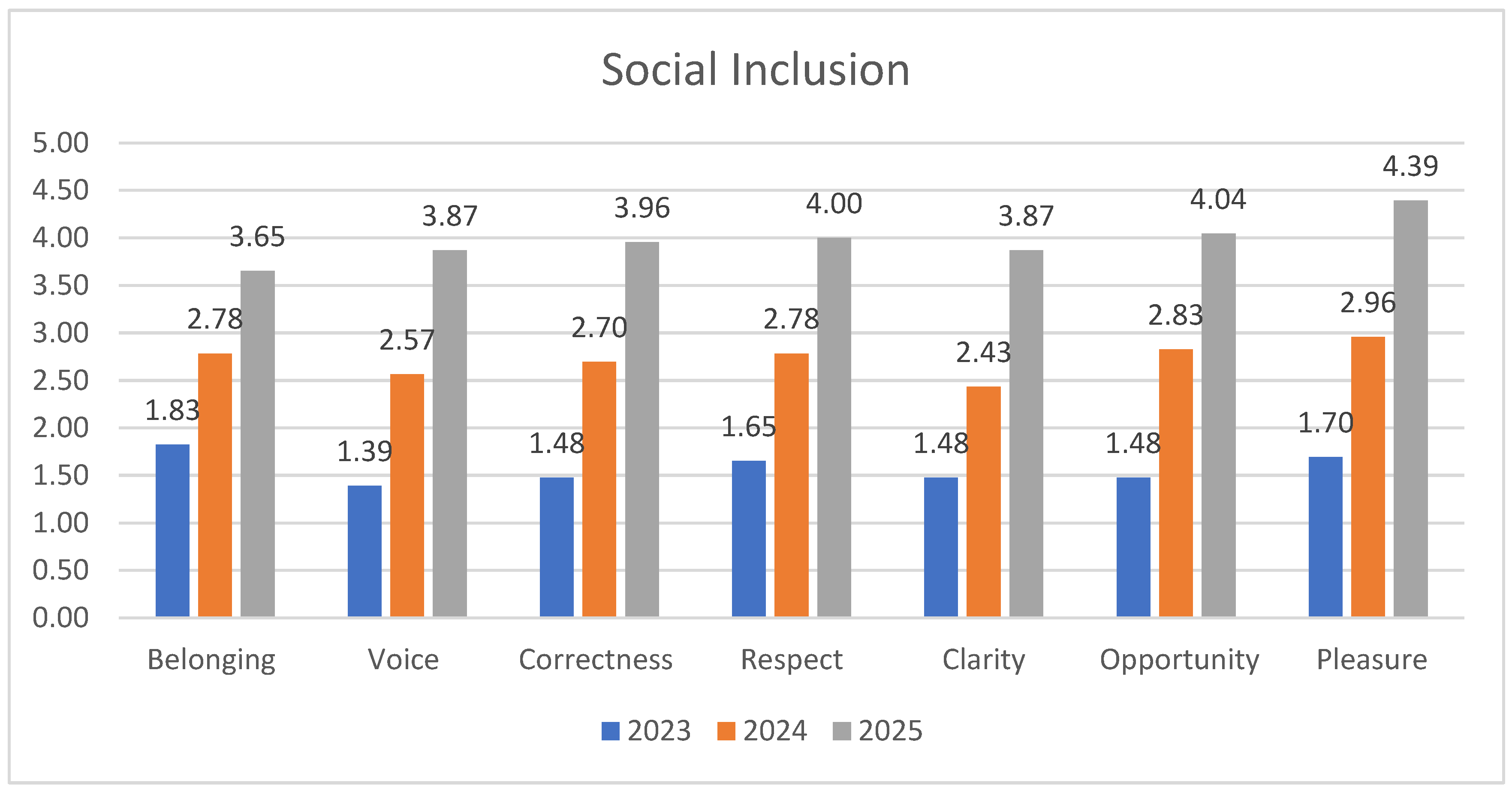
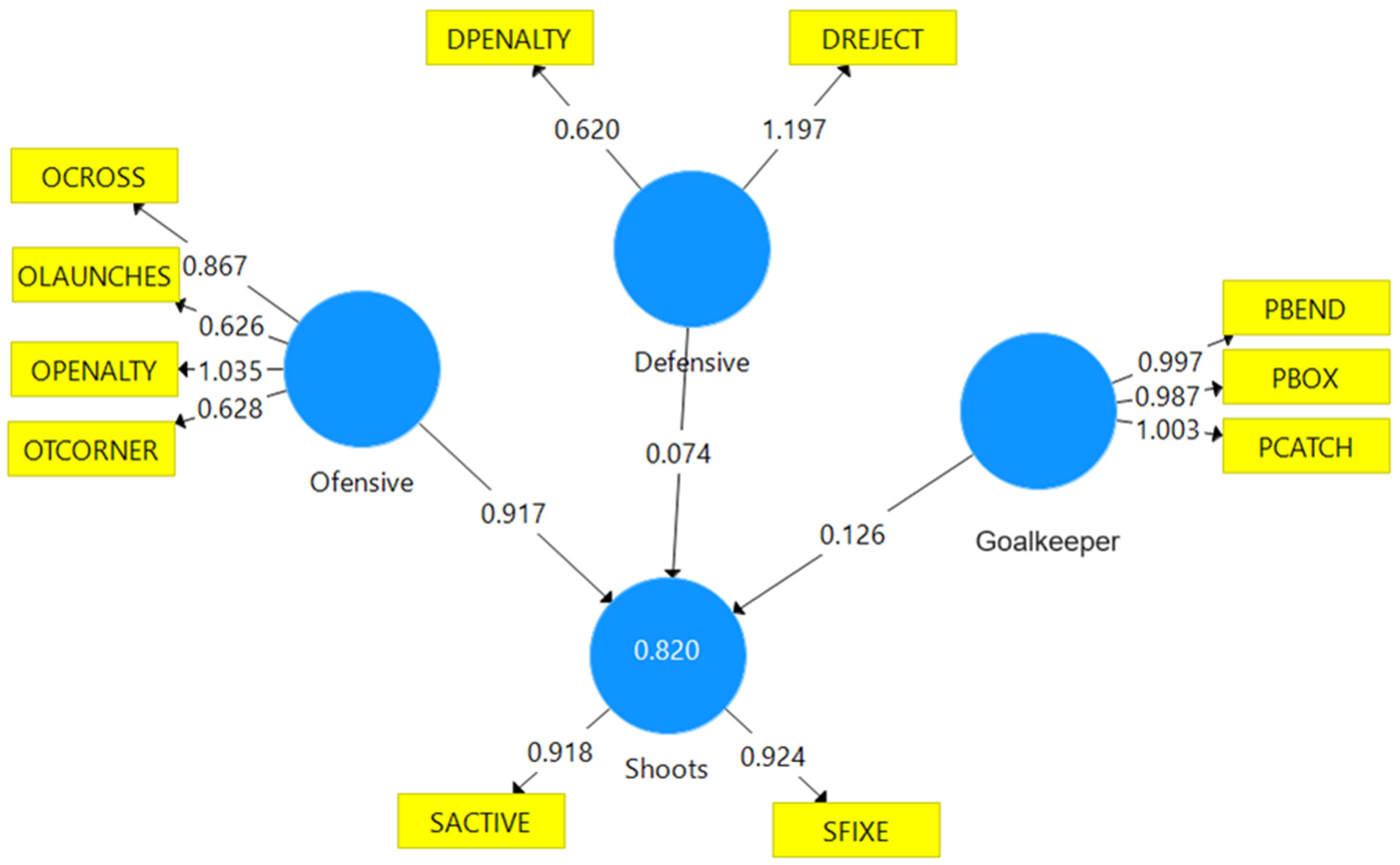
| Session Type | Task Constraints | Duration | Work: Rest | Intensity | Coaching Cues | Role Rotation | Total |
|---|---|---|---|---|---|---|---|
| 7v7 transition game | 2 | 2 | 2 | 1 | 2 | 2 | 11 |
| 9v9 Possession and pace of play | 2 | 1 | 2 | 1 | 2 | 2 | 10 |
| 4v4+4 control-oriented marking | 1 | 2 | 2 | 1 | 2 | 2 | 10 |
| 6v6+6 pressing and pressure | 1 | 1 | 1 | 1 | 2 | 2 | 8 |
| 9v9+4 transition game | 1 | 2 | 1 | 2 | 1 | 1 | 8 |
| 6v6 +6 control and passing | 2 | 2 | 2 | 2 | 2 | 2 | 12 |
| 8v8+4 defensive transition | 1 | 1 | 2 | 2 | 1 | 2 | 9 |
| Rondo with finishing | 1 | 2 | 1 | 2 | 1 | 1 | 8 |
| 3v3+3 defense in numerical inferiority | 2 | 2 | 2 | 2 | 1 | 2 | 11 |
| 9v9 Possession and pace of play with finishing | 2 | 2 | 2 | 2 | 2 | 2 | 12 |
| Variable | Average (1st Half) | Average (Return) | Diff. | T(df) | p-Value | Cohen’s d | 95% CI LL | 95% CI UL |
|---|---|---|---|---|---|---|---|---|
| OCROSS | 4.33 | 18.67 | 14.3 | 4.02 (5) | 0.01 | 1.64 | 5.17 | 23.5 |
| OCROSSPOSS | 1.83 | 11.83 | 10 | 3.63 (5) | 0.015 | 1.48 | 2.91 | 17.09 |
| OVERTLAUNCHES | 10.67 | 13.17 | 2.5 | 1.87 (5) | 0.12 | 0.76 | −0.93 | 5.93 |
| ODIAG- LAUNCHES | 4.67 | 14.17 | 9.5 | 2.74 (5) | 0.041 | 1.12 | 0.6 | 18.4 |
| OTCORNER | 0.33 | 15 | 14.7 | 10.80 (5) | 0 | 4.41 | 11.18 | 18.16 |
| OPENALTY | 0.5 | 3.83 | 3.33 | 2.71 (5) | 0.042 | 1.11 | 0.17 | 6.49 |
| OTROWEDGE | 10.5 | 5.5 | −5 | −1.82 (5) | 0.128 | −0.74 | −12.06 | 2.06 |
| OTROWSIDE | 9.67 | 7.33 | −2.3 | −0.73 (5) | 0.499 | −0.3 | −10.56 | 5.89 |
| Variable | Average (1st Half) | Average (Return) | Diff. | T(df) | p-Value | Cohen’s d | 95% CI LL | 95% CI UL | Shapiro p |
|---|---|---|---|---|---|---|---|---|---|
| DRECOVPANALTY | 29.83 | 22.17 | −7.7 | −1.28 (5) | 0.258 | −0.52 | −23.11 | 7.78 | 0.552 |
| DRECOVGATE | 33.5 | 17.5 | −16 | −5.20 (5) | 0.003 | −2.12 | −23.91 | −8.09 | 0.007 |
| DREVOCOWN | 21 | 16 | −5 | −1.73 (5) | 0.144 | −0.71 | −12.42 | 2.42 | 0.431 |
| DRRECOVOPP | 7.67 | 5.17 | −2.5 | −5.84 (5) | 0.002 | −2.38 | −3.6 | −1.4 | 0.82 |
| DREJECTFOOT | 17 | 11.5 | −5.5 | −2.34 (5) | 0.066 | −0.96 | −11.54 | 0.54 | 0.424 |
| DRREJECTHEAD | 13 | 8.5 | −4.5 | −1.60 (5) | 0.171 | −0.65 | −11.73 | 2.73 | 0.713 |
| DPENALTY | 2 | 1.33 | −0.7 | −0.76 (5) | 0.484 | −0.31 | −2.93 | 1.6 | 0.964 |
| Variable | Average (1st Half) | Average (Return) | Diff. | T(df) | p-Value | Cohen’s d | 95% CI LL | 95% CI UL | Shapiro p |
|---|---|---|---|---|---|---|---|---|---|
| SACTIVE | 0.5 | 4 | 3.5 | 1.73 (5) | 0.145 | 0.7 | −1.72 | 8.72 | 0.252 |
| SFIXE | 5.17 | 9.83 | 4.7 | 1.63 (5) | 0.164 | 0.67 | −2.68 | 12.02 | 0.746 |
| STOTAL | 5.67 | 13.83 | 8.2 | 1.78 (5) | 0.136 | 0.73 | −3.64 | 19.97 | 0.287 |
| Variable | CA | Rho_A | CR | AVE |
|---|---|---|---|---|
| Threshold | >0.7 | >0.7 | >0.7 | >0.5 |
| Defensive | 0.688 | 1.131 | 0.947 | 0.908 |
| Offensive | 0.886 | 0.921 | 0.878 | 0.653 |
| Goalkeeper | 0.997 | 0.997 | 0.997 | 0.991 |
| Shots | 0.918 | 0.918 | 0.918 | 0.849 |
Disclaimer/Publisher’s Note: The statements, opinions and data contained in all publications are solely those of the individual author(s) and contributor(s) and not of MDPI and/or the editor(s). MDPI and/or the editor(s) disclaim responsibility for any injury to people or property resulting from any ideas, methods, instructions or products referred to in the content. |
© 2025 by the authors. Licensee MDPI, Basel, Switzerland. This article is an open access article distributed under the terms and conditions of the Creative Commons Attribution (CC BY) license (https://creativecommons.org/licenses/by/4.0/).
Share and Cite
Paun, G.-D.; Enoiu, R.S.; Dima, M.D. Small-Sided Games in Youth Football: Advancing Technical–Tactical Performance and Social Inclusion for Sustainable Development. Sustainability 2025, 17, 9563. https://doi.org/10.3390/su17219563
Paun G-D, Enoiu RS, Dima MD. Small-Sided Games in Youth Football: Advancing Technical–Tactical Performance and Social Inclusion for Sustainable Development. Sustainability. 2025; 17(21):9563. https://doi.org/10.3390/su17219563
Chicago/Turabian StylePaun, Gheorghe-Dan, Razvan Sandu Enoiu, and Marius Dumitru Dima. 2025. "Small-Sided Games in Youth Football: Advancing Technical–Tactical Performance and Social Inclusion for Sustainable Development" Sustainability 17, no. 21: 9563. https://doi.org/10.3390/su17219563
APA StylePaun, G.-D., Enoiu, R. S., & Dima, M. D. (2025). Small-Sided Games in Youth Football: Advancing Technical–Tactical Performance and Social Inclusion for Sustainable Development. Sustainability, 17(21), 9563. https://doi.org/10.3390/su17219563






